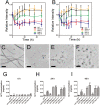Inhibitory effects of magnolol and honokiol on human calcitonin aggregation
- PMID: 26324190
- PMCID: PMC4555095
- DOI: 10.1038/srep13556
Inhibitory effects of magnolol and honokiol on human calcitonin aggregation
Abstract
Amyloid formation is associated with multiple amyloidosis diseases. Human calcitonin (hCT) is a typical amyloidogenic peptide, its aggregation is associated with medullary carcinoma of the thyroid (MTC), and also limits its clinical application. Magnolia officinalis is a traditional Chinese herbal medicine; its two major polyphenol components, magnolol (Mag) and honokiol (Hon), have displayed multiple functions. Polyphenols like flavonoids and their derivatives have been extensively studied as amyloid inhibitors. However, the anti-amyloidogenic property of a biphenyl backbone containing polyphenols such as Mag and Hon has not been reported. In this study, these two compounds were tested for their effects on hCT aggregation. We found that Mag and Hon both inhibited the amyloid formation of hCT, whereas Mag showed a stronger inhibitory effect; moreover, they both dose-dependently disassembled preformed hCT aggregates. Further immuno-dot blot and dynamic light scattering studies suggested Mag and Hon suppressed the aggregation of hCT both at the oligomerization and the fibrillation stages, while MTT-based and dye-leakage assays demonstrated that Mag and Hon effectively reduced cytotoxicity caused by hCT aggregates. Furthermore, isothermal titration calorimetry indicated Mag and Hon both interact with hCT. Together, our study suggested a potential anti-amyloidogenic property of these two compounds and their structure related derivatives.
Figures







Similar articles
-
Unveiling the Inhibitory Effect of Magnolol in the Aggregation of Human Calcitonin (hCT): A Comprehensive In-Silico Study.Chemphyschem. 2025 Jan 2;26(1):e202400679. doi: 10.1002/cphc.202400679. Epub 2024 Nov 20. Chemphyschem. 2025. PMID: 39432713
-
Magnolol and honokiol target TRPC4 to regulate extracellular calcium influx and relax intestinal smooth muscle.J Ethnopharmacol. 2022 May 23;290:115105. doi: 10.1016/j.jep.2022.115105. Epub 2022 Feb 11. J Ethnopharmacol. 2022. PMID: 35157953
-
Magnolia polyphenols attenuate oxidative and inflammatory responses in neurons and microglial cells.J Neuroinflammation. 2013 Jan 29;10:15. doi: 10.1186/1742-2094-10-15. J Neuroinflammation. 2013. PMID: 23356518 Free PMC article.
-
Advances on Semisynthesis, Total Synthesis, and Structure-Activity Relationships of Honokiol and Magnolol Derivatives.Mini Rev Med Chem. 2016;16(5):404-26. doi: 10.2174/1389557516666151120115558. Mini Rev Med Chem. 2016. PMID: 26586125 Review.
-
Insights on the Multifunctional Activities of Magnolol.Biomed Res Int. 2019 May 23;2019:1847130. doi: 10.1155/2019/1847130. eCollection 2019. Biomed Res Int. 2019. PMID: 31240205 Free PMC article. Review.
Cited by
-
A Systematic Screening of Traditional Chinese Medicine Identifies Two Novel Inhibitors Against the Cytotoxic Aggregation of Amyloid Beta.Front Pharmacol. 2021 Apr 9;12:637766. doi: 10.3389/fphar.2021.637766. eCollection 2021. Front Pharmacol. 2021. PMID: 33897425 Free PMC article.
-
Nanostructure and stability of calcitonin amyloids.J Biol Chem. 2017 May 5;292(18):7348-7357. doi: 10.1074/jbc.M116.770271. Epub 2017 Mar 10. J Biol Chem. 2017. PMID: 28283568 Free PMC article.
-
Honokiol decreases alpha-synuclein mRNA levels and reveals novel targets for modulating alpha-synuclein expression.Front Aging Neurosci. 2023 Aug 10;15:1179086. doi: 10.3389/fnagi.2023.1179086. eCollection 2023. Front Aging Neurosci. 2023. PMID: 37637959 Free PMC article.
-
Dopamine-Conjugated Carbon Dots Inhibit Human Calcitonin Fibrillation.Nanomaterials (Basel). 2021 Aug 30;11(9):2242. doi: 10.3390/nano11092242. Nanomaterials (Basel). 2021. PMID: 34578556 Free PMC article.
-
Molecular Insights into the Effects of F16L and F19L Substitutions on the Conformation and Aggregation Dynamics of Human Calcitonin.J Chem Inf Model. 2024 Jun 10;64(11):4500-4510. doi: 10.1021/acs.jcim.4c00553. Epub 2024 May 14. J Chem Inf Model. 2024. PMID: 38745385 Free PMC article.
References
-
- Kelly J. W. The alternative conformations of amyloidogenic proteins and their multi-step assembly pathways. Curr Opin Struct Biol 8, 101–6 (1998). - PubMed
-
- Stefani M. & Dobson C. M. Protein aggregation and aggregate toxicity: new insights into protein folding, misfolding diseases and biological evolution. J Mol Med (Berl) 81, 678–99 (2003). - PubMed
-
- Bucciantini M. et al. Inherent toxicity of aggregates implies a common mechanism for protein misfolding diseases. Nature 416, 507–11 (2002). - PubMed
-
- Chiti F. & Dobson C. M. Protein misfolding, functional amyloid, and human disease. Annual Review of Biochemistry 75, 333–366 (2006). - PubMed
Publication types
MeSH terms
Substances
LinkOut - more resources
Full Text Sources
Other Literature Sources
Research Materials

